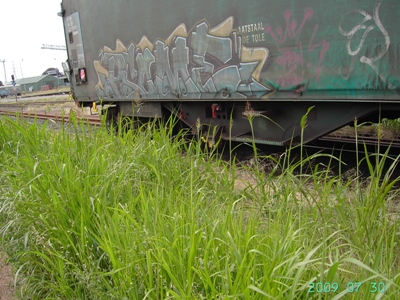Sorghum halepense (L.) Pers. (syn.: Andropogon halepensis (L.) Brot.) (trop., warm-temp. regions of the world) – A rather common, locally naturalized alien. Apparently first collected on rough ground in Schoten in 1884. Shortly afterwards also see in several different, widely scattered localities (Chokier, Kessel-Lo, Quaregon, Verviers, Wilsele, etc.). Most records are obviously associated with grain importation. Formerly also exceptionally seen as a wool alien in the valley of river Vesdre (only between 1892 and 1895). At present regularly found along motor- and highways, on unloading quays, under grain conveyors, in port- and urban areas, on garbage dumps, etc. Much increasing since the 1980’s (Robbrecht 1982) and now locally naturalized in Flanders, mainly by roadsides but also on rough ground (mostly but not exclusively in port areas, for instance in Gent). Sorghum halepense appears to be very persistent and seems resistant to most weed killers. Thus far it has not been recorded from agricultural fields but it is likely to become a weed problem in a near future. Reproduction always seems clonal (spreading through very tough rhizomes); viable seed is probably never produced in Belgium. Apparently much rarer in Wallonia; there probably only a rare ephemeral alien.
Most Belgian specimens seen are characterized by conspicuously awned bisexual florets. Plants with unawned spikelets, however, also occur (var. muticum (Hack.) Jansen et Wachter).
 |
 |
 |
 |
 |
 |
 |
 |
References
Danin A. (1983) Sorghum halepense (L.) Pers. and S. virgatum (Hack.) Stapf in Israel. Israel J. Bot. 32(3): 172-173.
Essl F. (2005) Invasionsgeschichte und pflanzensoziologischer Anschluss der Aleppohirse (Sorghum halepense) am Beispiel des östlichen Oberösterreich. Tuexenia 25: 251-268.
Follak S. & Essl F. (2012) Spread dynamics and agricultural impact of Sorghum halepense, an emerging invasive species in Central Europe. Weed Research 52(6) (in press).
Lambinon J. (1957) Contribution à l’étude de la flore adventice de la Belgique. I. Adventices rares ou nouvelles pour la Belgique. Bull. Soc. Roy. Bot. Belg. 89: 85-100.
Robbrecht E. (1982) Sorghum halepense (L.) Pers. in uitbreiding in Gent en omgeving (Oost-Vlaanderen, België). Dumortiera 23: 17-22.
Robbrecht E. (1983) Autosnelwegneofieten, een kategorie van graanadventieven in opkomst? Dumortiera 26: 6-13.
Warwick S.I. & Black L.D. (1983) The biology of Canadian weeds. 61. Sorghum halepense (L.) Pers. Can. J. Pl. Sc. 63: 997-1014.
Warwick S.I., Thompson B.K. & Black L.D. (1984) Population variation in Sorghum halepense, Johnson grass, at the northern limits of its range. Canad. J. Bot. 62(9): 1781-1790.

